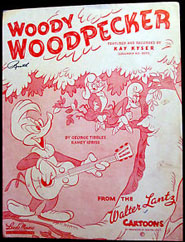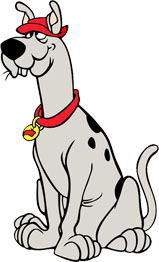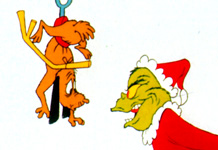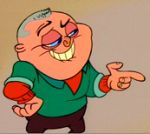
The Cow Problem. Animation producer Walter Lantz discussed in the January 4, 1958 issue of TV Guide some of the difficulties with using his classic animated shorts on his new television show: “Cows could have been a big headache for us on TV but fortunately we took care of that problem when we originally made the cartoons for the movie houses. All our cows wear skirts and, of course, we never show anyone milking a cow.” In the first week of February 1931, Motion Picture Producers & Distributors of America announced to the press that because of complaints of many local censor boards, the showing of udders on cartoon cows was now banned. When an udder must be shown, it would be very small and no longer used for extreme gags of stretching.
 The Woody Woodpecker Song. “The Woody Woodpecker Song” was the first and only song from an animated short to be nominated for an Oscar for Best Song. Written in 1947 by two former Lantz musicians Ramey Idriss and George Tibbles, the tune was performed and recorded by Kay Kyser’s orchestra and became an instant hit – selling 250,000 records within the first ten days of release.
The Woody Woodpecker Song. “The Woody Woodpecker Song” was the first and only song from an animated short to be nominated for an Oscar for Best Song. Written in 1947 by two former Lantz musicians Ramey Idriss and George Tibbles, the tune was performed and recorded by Kay Kyser’s orchestra and became an instant hit – selling 250,000 records within the first ten days of release.
As a result, Walter Lantz slipped the song immediately into Wet Blanket Policy (1948) which was in production at the time, and qualified it for an Oscar consideration. It won a nomination, but lost out to “For Every Man There’s a Woman” from the movie Casbah with music by Harold Arlen and lyrics by Leo Robin. “Buttons and Bows” from The Paleface by Jay Livingston and Ray Evans.
A slighted Mel Blanc recorded an equally popular cover version and initiated a lawsuit against Lantz. Blanc lost basically on the grounds that he never copyrighted the laugh. However, before the case went to the California Court of Appeals, Lantz personally reached out to Blanc and reached an out-of-court settlement.

Scooby-Dum
Scooby Doo’s Relatives. Scooby Doo came from a big litter. In addition to his nephew, Scrappy Doo, Scooby Doo’s relatives included his brothers Yabba-Doo, Skippy-Doo and Howdy-Doo as well as cousins Scooby-Dee, Scooby-Dum, Whoopsy-Doo, Skippy-Doo, Dixie-Doo and of course, Dooby-Doo. Scooby had a sister Ruby Doo, the mother of Scrappy Doo. Scooby’s mother and father were Momsy and Dada Doo. His mother called Scooby “Scoobert”.
Belzer’s Conspiracy Chronicles. The script for the pilot episode of Belzer’s Conspiracy Chronicles was turned in to HBO in September 1998. The show was to be animated including star Richard Belzer (known for his stand up comedy and for his role as a detective in the television series “Homicide: Life on the Street,”) as the Man in Black narrator of the show. Belzer’s Conspiracy Chronicles was based on The Big Book of Conspiracies and The Big Book of the Unexplained. The first episode would have featured the stories: “Coincidence or Consequence?”, “The Astronauts and the Aliens”, and “The Psychadelic CIA”. I don’t believe this series ever aired although the Sci-Fi Channel did air a non-animated series called The Belzer Connection that discussed conspiracies.
 Jones the Grinch. “Ted (Geisel, better known as Dr. Seuss) was very patient with me (on the making of How The Grinch Stole Christmas),” stated director Chuck Jones. “But we did have an argument about how to draw the Grinch. He felt that my Grinch looked more like me than his Grinch.” Jones’ grandaughter Valerie (who later became an artist) was the model for Cindy Lou Who. Max the Dog according to Jones was based on a fox terrier he owned when he was six years old.
Jones the Grinch. “Ted (Geisel, better known as Dr. Seuss) was very patient with me (on the making of How The Grinch Stole Christmas),” stated director Chuck Jones. “But we did have an argument about how to draw the Grinch. He felt that my Grinch looked more like me than his Grinch.” Jones’ grandaughter Valerie (who later became an artist) was the model for Cindy Lou Who. Max the Dog according to Jones was based on a fox terrier he owned when he was six years old.
Death of Duke. In G.I. Joe: The Movie (1987), Duke, the leader of the G.I. Joes was to die from a spear tossed by Serpentor. In the original script, the Joes held a funeral prior to the final battle. However, after Transformers: The Movie (1986) was released with the death of Optimus Prime that resulted in a severe backlash from parents and fans, Hasbro had a change of mind. The scene was kept but new replacement dialogue was inserted to indicate Duke was in a coma (and at the end of the film there was dialog to state he had come out of his coma). Writer and story editor Buzz Dixon stated, “[If] you watch the visuals and don’t listen to the soundtrack, it’s obvious Duke dies.”
 Origin of George Liquor. “(The character) George Liquor came from a liquor store called ‘George Liquor’. I saw that sign and this guy instantly popped into my head. This short, stocky guy out in the woods with a shotgun, beer cans littered all over the place, wiping out the environment. I saw the words and just started laughing,” said animator John Kricfalusi in 1999.
Origin of George Liquor. “(The character) George Liquor came from a liquor store called ‘George Liquor’. I saw that sign and this guy instantly popped into my head. This short, stocky guy out in the woods with a shotgun, beer cans littered all over the place, wiping out the environment. I saw the words and just started laughing,” said animator John Kricfalusi in 1999.
The WB animated Superman Theme Song. Shirley Walker provided the musical scores for such animated series as Spawn, Batman and Superman. “On the animated Batman I got lucky,” said Walker. “The producers loved the first theme that came out, and we were fine. We all agreed that there was a darkness to the Batman character that we wanted the music to state.
“The Superman theme, though, is the second one I did for the show. At first we wanted to do the theme differently not what you’d expect: John Williams-sounding. We didn’t want to use ‘Superman’ rhythmically in the music, but we wanted it to have the feel of American cities of the 1940s. We ended up with ‘Su-per-Man!’ and ‘da-da-DAAH!’ I created themes for all the major characters on Batman, and we do bring them back from show to show, which is a lot of fun actually. I work at the time-honored piano keyboard with pencil and paper. Batman is completely written out and orchestrated.”


 Jim Korkis is an internationally respected animation historian who in recent years has devoted his attention to the many worlds of Disney. He was a columnist for a variety of animation magazines. With his former writing partner, John Cawley, he authored several animation related books including The Encyclopedia of Cartoon Superstars, How to Create Animation, Cartoon Confidential and Get Animated’s Animation Art Buyer’s Guide. He taught animation classes at the Disney Institute in Florida as well as instructing classes on acting and animation history for Disney Feature Animation: Florida.
Jim Korkis is an internationally respected animation historian who in recent years has devoted his attention to the many worlds of Disney. He was a columnist for a variety of animation magazines. With his former writing partner, John Cawley, he authored several animation related books including The Encyclopedia of Cartoon Superstars, How to Create Animation, Cartoon Confidential and Get Animated’s Animation Art Buyer’s Guide. He taught animation classes at the Disney Institute in Florida as well as instructing classes on acting and animation history for Disney Feature Animation: Florida.




















































Where’d you get the Woody picture at the top from?
The Woody image is from the January 1958 TV Guide article which Jim links to in his first sentence.
“The Woody Woodpecker Song” lost to “Buttons and Bows” from The Paleface.
Duly noted – and corrected above. Thanks!
I had known about Mel Blanc’s lawsuit. I believe that it was brought because Lantz was using old soundtracks of Mel’s Woody laugh on newer cartoons without his permission, after WB signed him exclusively. I also knew that, because he could not answer “Yes” to the judge who asked him if he had copyrighted the laugh (notes), Mel lost the case. What I did NOT know was that Lantz reached out to Mel before the case could go to a higher court, and settled with him privately! In the 11 years that I knew Mel personally, that subject never came up. (Lantz always came across to me as being a decent man, though I never met him. Therefore, his voluntarily settling with Mel does not surprise me!) Thank you, Jim!
Walter Lantz loved to tell the story of how there was a radio show on the air at the time called “Your Hit Parade” which would count down the country’s top radio hits. The resident singer on the show would sing those hits with the orchestra. For several weeks running, the number one hit was “The Woody Woodpecker Song” and the poor singer was stuck having to sing it at the very end of the show. That singer’s name? Frank Sinatra! Lantz got a huge kick out of the fact that Sinatra had been forced to repeatedly sing that song.
When I made my short documentary on the life of Walter Lantz, “Walter, Woody and the World of Animation” back in 1980, I called an old friend of mine from Boston who was an avid radio show collector and asked if he had an episode of “Your Hit Parade” in which Sinatra sang the “Woody” song. He did. On the tape, you can hear Sinatra’s humorous, frustrated response to having to sing it, obviously not for the first time. “Oh no, not this song again!” he says as the audience bursts into laughter. I’ll never forget how happy Walter was when I presented him a copy of that episode. He was thrilled! We included the audio clip in the documentary and it was in the version that played for several years at Universal as part of the Universal Studios Tour.
But when Universal first released the documentary on VHS years later as part of a Woody cartoon collectrion, the Sinatra song was edited it out at Lantz’s request. He did not want to offend Sinatra, and probably didn’t want to bother obtaining rights to release it. The Sinatra song is still omittted in the version of the documentary that’s included in the currently-released DVD collection of Woody cartoons, but I still have a 16mm print of the complete version lying in a box somewhere in storage, and another print of the full version was donated by Walter to the Smithsonian.
He did not want to offend Sinatra, and probably didn’t want to bother obtaining rights to release it. The Sinatra song is still omittted in the version of the documentary that’s included in the currently-released DVD collection of Woody cartoons, but I still have a 16mm print of the complete version lying in a box somewhere in storage, and another print of the full version was donated by Walter to the Smithsonian.
Too bad they couldn’t reinstate it on the DVD but I suppose it was for the best.
Sinatra singing “The Woody Woodpecker Song” on Your Hit Parade can be streamed here:
http://www.myoldradio.com/old-radio-episodes/your-hit-parade-first-song-haunted-heart/2
skip ahead to about 24 minutes in.
Was it Clarabelle or another early cartoon cow who briefly wore a skirt between her legs to cover her udders? I remember thinking that was more creepy than a naked cow.
It was Clarabelle, in THE SHINDIG (1930) and BLUE RHYTHM (1931). After that, the skirt covered her legs.
It was Clarabelle, in THE SHINDIG (1930) and BLUE RHYTHM (1931). After that, the skirt covered her legs.
Pretty much after that point you can forget her having udders at all the way she was designed in future cartoons like “Mickey’s Fire Brigade” or the remake of “Orphan’s Benefit”.
Where was the George Liquor character seen? I’m not familiar with him.
He was seen in “The Ren & Stimpy Show” in episodes like “Man’s Best Friend (which was banned back in 1991, but finally release on the spin off “Adult Party Cartoon”.) and “Dog Show” (He also makes a cameo in “The Boy Who Cried Rat!”).
http://www.youtube.com/watch?v=C52ltikN3rY
http://www.youtube.com/watch?v=E9SBd4y9opY
http://www.youtube.com/watch?v=WpS96rhH_Z4
He also had his own Flash cartoon series “The Goddamn George Liquor Program” in 1997, and appeared in various commercials.
http://www.youtube.com/watch?v=NLAWapFehnU
http://www.youtube.com/watch?v=s144MgSHGIo
George Liquor was also in the Spumco comic book series that was formerly published by Dark Horse and Marvel almost 20 years ago but has since saw a reprint by IDW a while back.
http://www.treasurycomics.com/gallery/galleryOTHERspumco.htm
In the first week of February 1931, Motion Picture Producers & Distributors of America announced to the press that because of complaints of many local censor boards, the showing of udders on cartoon cows was now banned. When an udder must be shown, it would be very small and no longer used for extreme gags of stretching.
And I suppose that’s what gave rise to the approved splendor that is Molly Moo-Cow.
Scooby Doo’s Relatives. Scooby Doo came from a big litter. In addition to his nephew, Scrappy Doo, Scooby Doo’s relatives included his brothers Yabba-Doo, Skippy-Doo and Howdy-Doo as well as cousins Scooby-Dee, Scooby-Dum, Whoopsy-Doo, Skippy-Doo, Dixie-Doo and of course, Dooby-Doo. Scooby had a sister Ruby Doo, the mother of Scrappy Doo. Scooby’s mother and father were Momsy and Dada Doo. His mother called Scooby “Scoobert”.
And you thought Donald Duck had such a big family in the comics!
Imagine the family reunions!!!